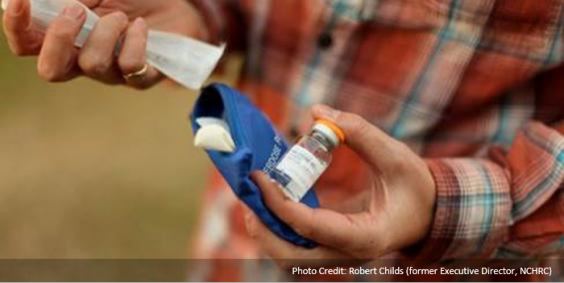Naloxone access and North Carolina Harm Reduction Coalition

During the past 10 years, North Carolina has faced an all too common problem: rising rates of opioid use and overdose deaths. The North Carolina Harm Reduction Coalition (NCHRC) aims to reduce harm for those engaging in high risk activity, such as drug use. Their advocacy and coalition building, along with direct services and resource development, have led to changes in North Carolina’s laws, which have saved thousands of lives.
One of the NCHRC’s objectives is to expand access to naloxone, an effective prescription medication which reverses opioid drug overdose. A few years ago, in most states, naloxone could only be obtained by visiting a doctor for a prescription, which wasn’t always easy: a physician might be unwilling to prescribe it, an individual in need might not know about naloxone, lack insurance, or be reluctant to admit drug use. Additionally, those present during an overdose risked legal consequences, such as prosecution for drug possession or violation of probation or parole. The NCHRC aimed to increase the opportunity for individuals to acquire and provide naloxone, more easily connect providers with those who could use it, and ensure legal protections for those prescribing, providing and administering the medication via Good Samaritan provisions.
The NCHRC began meeting with faith leaders, veterans, medical leaders, law enforcement, community members, and other decision makers to help build understanding of the benefits of expanding naloxone access and making it easier to call 911 without unintended consequences. Getting accurate information into the media was also key. This groundwork helped NCHRC staff work successfully with state lawmakers to pass the 911 Good Samaritan/Naloxone Access Law in April of 2013 and strengthen it in 2015. (2021 update: These laws have been more widely adopted since this post was originally published.)
The legislation (SB-20 in 2013 and SB-154 in 2015) expands access and offers conditions for legal immunity for victims of overdose, individuals assisting during an overdose, and providers of naloxone (e.g., physicians and pharmacists). Physicians can now write “standing orders” for naloxone, meaning that one physician can write a prescription for multiple patients. The NCHRC, instituted the first standing order for naloxone in community settings in the Southern US. The standing order allows any employee, even a contractor, to distribute naloxone to people at risk, bringing naloxone directly to drug users and their loved ones in the community more easily. Most recently, North Carolina pharmacies have been authorized to provide naloxone, under a standing order, so that anyone can request naloxone.
More information and links to the full text of the law is available here.
NCHRC continues to support the law’s implementation with their targeted Overdose Prevention Project (OPP) and official “Overdose Rescue Kit.” The group has established partnerships with addiction treatment centers and methadone/buprenorphine clinics throughout the state to help ensure individuals are given a naloxone kit as part of their treatment. They have also recruited a dedicated network of volunteers who help provide naloxone access for those who cannot easily visit a clinic or pharmacy. Drug user and law enforcement feedback have been critical in establishing this distribution network, which includes rural, suburban and urban drug courts, drug user groups, and syringe services programs.
Ongoing coordination with law enforcement, medical professionals, and community members to provide comprehensive responder training for opioid overdose reversal is also key. Between August 2013 and 2016, the NCHRC has tracked overdose reversals and confirmed use of their rescue kits; they report distribution of 33,700 kits and over 4,514 overdose reversals as of September 15, 2016. Law enforcement in NC during this time period used naloxone over 185 rescues.
Neighboring states, like Georgia, have collaborated with the NCHRC and are making strides in reducing rates of overdose. For more information on naloxone access or working with the NCHRC, visit their website or contact Jesse Bennett, Executive Director, at [email protected] or (336) 543-8050. A County Health Rankings & Roadmaps webinar featuring more information about the NCHRC’s work on naloxone access is available here.
Communities in Action provide examples of strategies or tools in action. Their purpose is to connect like-minded communities in their implementation efforts, giving insight into how others are tackling key challenges and what they've accomplished. To learn more about the evidence supporting this strategy's effectiveness or resources to help move towards implementation, see the What Works for Health summary of Naloxone education & distribution programs.
Date added: September 26, 2016
